 134Likes 134Likes
 |
|

30 Oct 2014
|
 |
Registered Users
Veteran HUBBer
|
|
Join Date: Nov 2010
Location: Santa Cruz, California
Posts: 316
|
|
|
Skirting the Serengeti and Seeking the Source of the Nile

We left Nairobi with a plan to circle Lake Victoria, which meant crossing into Tanzania for a third time since we entered east Africa.  We blazed southwest along the edge of the Serengeti towards the town of M'wanza. At one stage Jamie tapped me on the shoulder and pointed to our left and I turned to see the grassy plain dotted with Acacia trees filled to the horizon with zebra and wildebeest. This was our the view of the Serengeti Plain spreading to our south as we rode along. The wildebeest and zebra paid us no mind as we gazed across the scene in the subdued light of the late afternoon. It was one those unexpected, enchanted-feeling moments that happen from time to time on the road that leaves you beaming a stupid grin inside of your helmet and removes any doubt that there's any place else in the world you’d rather be than right where you are.

We camped along the shores of Lake Victoria by night and picnicked on peanut butter and jelly sandwiches by day. The road turned to rich red earth and short showers came and went as we rode, but we didn’t mind, they felt good, like the landscape was alive and we were part of it. The comfort and familiarity that we enjoyed temporarily in Nairobi was gone, we were out in it again.


At the campsite in M’wanza we met the proprietor of the local yacht club who coincidentally had provided some assistance to two Aussie guys on bikes who we’d met before leaving Nairobi. One of the Aussie guys had cartwheeled his BMW GS1200 avoiding a kid that darted unexpectedly into the road. The rider walked away virtually unscathed from the crash and the kid was untouched, but the bike was in awful shape when it arrived in Nairobi. As the helpful yacht club owner tells it, he helped keep the Aussie guy out of courtrooms and jail after the incident. It was a stark reminder to us that all of this joyful adventure comes at the cost of some risk and that we should keep our wits about us if we want it to carry on.
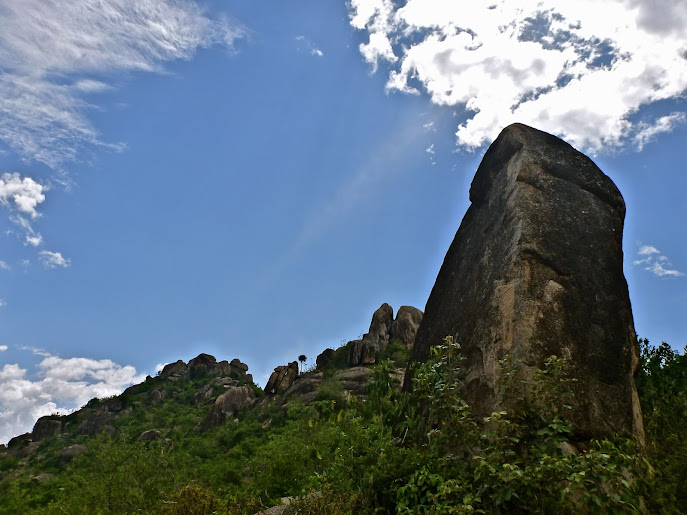
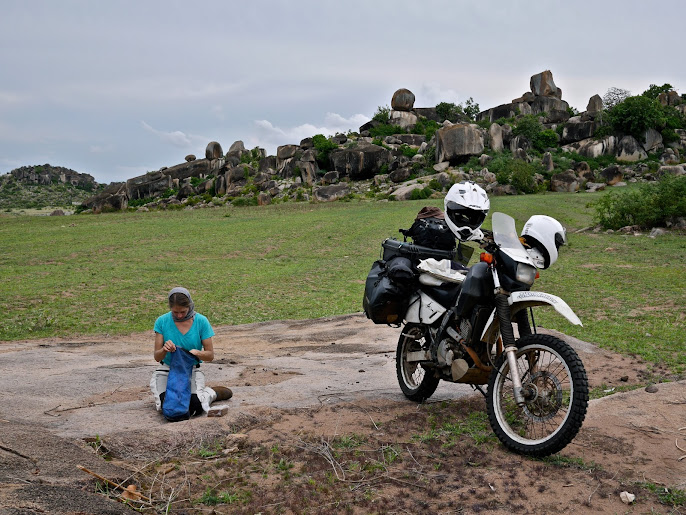
As we neared Burundi, the hills erupted into granitic domes and fortress-like piles of boulders, which made for some excellent picnic spots. We didn’t have visas for Burundi and weren’t sure whether or not they would let us in, but they welcomed us warmly and we found all of the people we met incredibly friendly. We encountered a corridor of people walking along the roadside so thick that I virtually had to ride right in the middle of the road most of the time. The roadside crowd persisted for almost all of our route through Burundi. Thankfully, there was very little traffic, since I had become so used to riding on the left side of the road in southern Africa. I couldn’t seem to remember to stay on the right hand side as they do in Burundi and Rwanda. People aren’t so used to tourists in Burundi as they are in Kenya and Tanzania. When we stopped at a bakery for some breakfast one morning a massive crowd gathered, curious about the strange white visitors on the big motorbike.
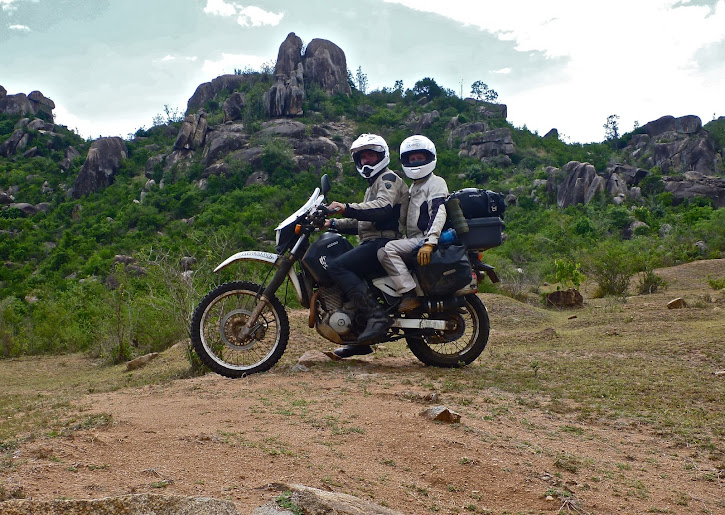
We rode a perfect tarmac road with no traffic to the border with Rwanda leaning in and out of sweeping turns that seemed never to end. Cultivated fields and a silty brown river flanked the road as it climbed and dropped from one hill to another. All along, we met the waves of kids and their cries of ‘Muzungu!’ (Swahili for white man). My speed crept up as I was having fun railing through one turn after another, and on one right-hand sweeper I felt the rear tire just barely start to break traction under throttle.
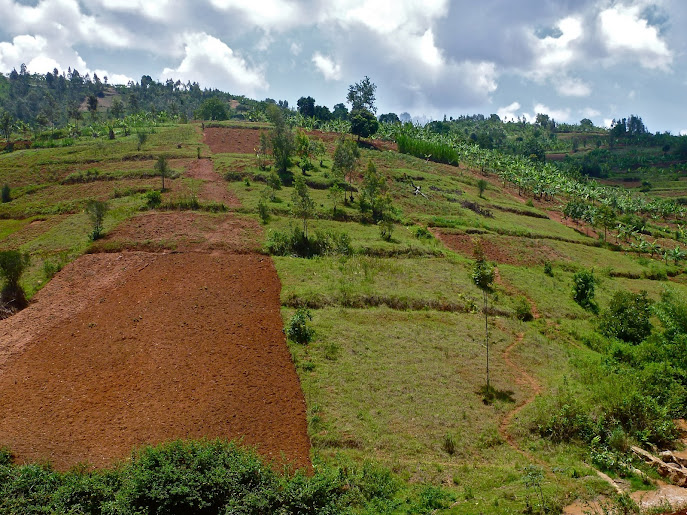

It wasn’t until we reached the Rwandan border that Jamie realized that she’d left her Kindle at the guest house we’d stayed at the previous night in Burundi. I got mad at her about it since it meant 3 hours more riding to backtrack to the town of N’goza to retrieve it. Riding the twisty road through a beautiful landscape filled with friendly people managed to dissolve any upset feelings pretty quickly. Along the way we passed very few motorbikes, but lots and lots of people on bicycles, either racing at high speed down the hills or arduously pushing up a slope. Often, the bicycles were loaded heavily with bananas and after passing some of these folks for the third time heading back to the border, I began to feel as though it was wrong not offer help. Here is this guy sweating and pushing a bike up a hill and we go zipping by on this powerful motorbike over and 0ver again, feeling just fine about it because we’re insulated by a cultural separation. If I wasn’t such a lazy selfish bastard, I would have tried harder to span that cultural void between us, stop and pile a load of bananas onto the bike.


Most of the valleys and hillslopes are cultivated. As it turns out, 85% of the land area of Rwanda is either used for some type of cultivation or fallow. The rest is mostly occupied by Eucalyptus groves that were planted mostly for harvest as firewood.

Everywhere in Rwanda, we’re reminded of the tragedy the world allowed to happen here not so long ago. The genocide of 1994 claimed more than 1 million lives within only a few months time and touched nearly everyone in the country in one way or another. Peoples' stories of that time are wrenching to hear. Monuments like the one in the photo above can be found throughout the country, even in the remote countryside. It seems as though nowhere was safe from the carnage brought by those who slaughtered grown men and schoolgirls alike based on an ethnic categorization scheme that was formalized by Europeans during colonial times. Many of the monuments prominently bear the simple proclamation that seems to embody Rwandans' attitude about what happened in 1994: ‘Never again’.

We headed west towards Lake Kivu, from where we hoped to explore the headwaters of the longest River on the planet. In Sudan, the Nile splits into the Blue Nile and the White Nile, the latter being the longer of the two branches. The source of the White Nile was one of the most hotly debated geographical enigmas of the 19th century, leading a sequence of expeditions and explorers claiming that they had identified the ultimate source of the mighty river. In 1858, with very little evidence available, the English explorer John Hanning Speke proclaimed Lake Victoria, jointly ‘discovered’ by himself and Richard Burton a year prior, to be the source of the mighty river. One expedition followed another over decades of exploration that attempted to provide compelling evidence of continuity of waterbodies stretching from upstream away from Lake Victoria through Tanzania, Uganda, and Zambia, to find the ultimate headwaters of the Nile. By the year 1874 and the death of the famed Scottish explorer Dr. David Livingstone, the riddle still remained unsolved, when Henry Stanley embarked on a three year expedition that finally confirmed relationships of potential sources identified by previous explorers and the Rukarara river as the most distant headwater of the worlds longest river.
In 2006, a crew of three New Zealanders made a bid to ascend the entire longitudinal distance of the Nile all the way to its most remote source by boat. After months of hardship and surviving an assault by Ugandan rebels when a good friend of the expedition was killed and the others injured, they finally reached the most remote tributary deep in the Nyungwe forest of Rwanda on the slopes of Mount Bigugu which turned out to be 107 kilometers longer than the previously identified most remote source. They provided the coordinates at the termination of their journey, and having been trained as a hydrologist, I could hardly resist the opportunity to go find it, so off we went.

Immediately upon leaving Lake Kivu the road turned to mud. As we climbed higher above the lake, the track degraded to a rocky mess. We nearly took it down a time or two when Dyna Rae’s rear wheel spun for traction on a few loose uphill sections or I took the wrong line through a nasty rutted section, but for the most part, we slowly tractored our way up the hillsides. After 10 miles of this, we stopped and considered whether this little expedition was really worth the trouble as dark clouds gathered overhead.

The pattern in the days leading up to this one were for the storms to start dumping rain in the afternoon, but the dark clouds gathering overhead told us that the rain may come early this day. If it did, the track would quickly become much more difficult to ride. We decided that if the Kiwi explorers survived rebel attacks, the least we could do was to carry on in the face of some rain. Thirty miles of rough track led us to the Gustavou tea plantation and their vast fields of tea plants.

The location specified by the Kiwi 'Ascend the Nile' expedition wasn’t far off, but the sky had finally started to let go the rain. We were too deep in now to stop, so we carried on and identified the location reached by the expedition. It was just over the hills in a Eucalyptus grove in the distance, but the tea fields barred our way from following in their footsteps to reach it.

We found the small tributary on the map closest to the coordinates marked by the expedition, traced it downstream and headed to where we could access the stream. We stood along the hydrologic divide between the Congo and Nile river basins, the two largest drainages on the African continent. By our reckoning, just 2 kilometers upstream of the flow that you see below is the most remote headwater of the Nile River.

|

30 Oct 2014
|
 |
Registered Users
Veteran HUBBer
|
|
Join Date: Jan 2006
Location: Yuma, Arizona, USA
Posts: 548
|
|
|
Once again--amazing photography! And explanations to go with them...Who would have thought that the mighty Nile is but a few drops?
|

6 Nov 2014
|
 |
Registered Users
Veteran HUBBer
|
|
Join Date: Nov 2010
Location: Santa Cruz, California
Posts: 316
|
|
|
Video! Surfing the Wild West..
|

13 Nov 2014
|
 |
Registered Users
Veteran HUBBer
|
|
Join Date: Nov 2010
Location: Santa Cruz, California
Posts: 316
|
|
|
Mzungus in the Mist

Before we left Kigali, Jamie and I spied a large, bright green snake slithering about just beneath a highway overpass while walking to the market.  On the way back we found the snake dead and learned that it was a Green Mamba, with a bite that is poisonous enough to kill several adults. It felt like a uniquely African urban hazard.
We rode from Kigali, crossed Rwanda’s border with Uganda, and continued to the town of Kabale, located near the shore of Lake Bunyoni. Our mission here was to inquire about the mountain gorilla tracking excursions into Bwindi Impenetrable Forest located just to the north of Kabale. We learned that within a week the official start of the rainy season would be upon us and the tracking permits would be half price, so we had some time to hang around in this dusty little town. All it takes is a few days in a place like this and we know our way around town, we have our favorite restaurant, regular grocery shop, and morning bakery, and of course have some new friends in the workers of the guest house. In fact, in our experience Uganda could certainly rival Malawi for the title of the ‘warm heart of Africa’. People are happy to see foreigners visiting and we’re greeted with smiles from strangers around every turn.

Our favorite $2.50 local fare buffet was located directly across from the power-ballad mini market. Perhaps simply because the owner had a massive set of speakers at his disposal and access to electricity 5 hours a day, he would provide an afternoon soundtrack for block with hits from Celine Dion, Phil Collins, and Journey. We had a few emotive lunchtime lip-synching sessions. As always, there was a dance party happening somewhere in town most nights that didn’t stop until dawn. In Africa, where there is electricity, there is a usually an all-night dance party on the weekend.

Though it was now raining every day, we still managed to get out to Lake Bunyoni for a few days of camping while we waited for our gorilla tracking permit date to arrive. We took one of the dugout canoes to paddle to an island in the middle of the lake, which ended up being more difficult that I first imagined. The problem was keeping the canoe going in a straight line. If we drifted even slightly to one direction we would soon find ourselves spinning a full 360 degrees around, doing what the locals called the ‘Mzungu corkscrew’ (Mzungu being the Swahili word for white folk). The local guys seemed to have no trouble keeping a constant heading and usually laughed at us spinning around in circles.

I too laughed eventually, but in the moment I was anything but amused at my wonky paddling struggles. We made our way out to an island in the middle of the lake, had lunch and took a swim.

Lake Bunyoni traces such a craggy shoreline and the roads are so poor that canoes are the preferred mode of transport for people, goods, and even delivering the local kids to and from school.

After a week in Kabale and Lake Bunyoni, we finally rode off into the mountains ready to spy some gorillas. We rode to regular calls of ‘Mzungu!’ from local village kids along the way, and sometimes the air of wide-eyed wonder in the way that they said it had us laughing. All the way up the twisting mountain roads, towering hillslopes were absolutely covered with cultivated fields from top to bottom.

Imagine the effort to walk to and from your field carrying tools or a harvest if it happened to be on the opposite end of one of these hills from your village. People are working hard for the food that they grow here.
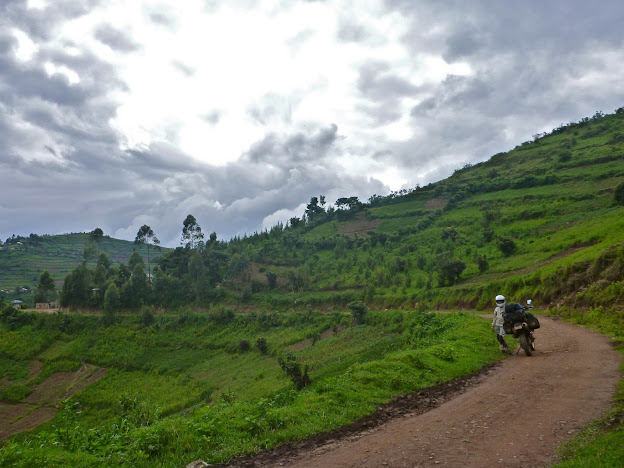
Our campsite in the mountains was little more than a clearing in the jungle pressed right up against the wall of dense vegetation that was teeming with life. A dizzying diversity of birds, snakes, lizards, insects, and of course gorillas and chimpanzees all inhabited this forest. At night this jungle produced a symphonic wall of sound that lulled us to sleep in our tent. It felt like an auditory analog to the impenetrable barrier of vegetation that formed the forest margin, reminding us that beyond that threshold, humans are merely visitors.

To us foreigners it’s an exotic and wild place, but the villagers here live their whole lives right up against it. Their fields and huts run right up to where the jungle and we were told that they’ve even had the gorillas wander right down into our camp.
We got up early the morning that we were to head into the jungle to meet our guide and have a bit of gorilla etiquette training. He said not to look them directly in the eyes, and if they become aggressive to make gorilla noises and pretend to be eating leaves. If one of them begins to charge us, we should slowly back away, but definitely do not run. Easy for the guy with the gun to say. Sounds reasonable, 700 pound gorilla closing fast, just stay cool, continue grunting ‘ooo…ooo….ooo’ and munching my palm leaf.

Newly armed with expert knowledge on staying friendly with our fellow primates, we began the walk into the jungle. The trail quickly turned to an extremely steep, muddy slope with barely a passage through the vegetation. Our way seemed to be more a gorilla trail than a human trail. Trackers had set out ahead of us early in the morning to help us find a specific family of gorillas called the Nshongi group. The trackers begin at the last place that the gorillas slept the night before (since they move sleeping locations every night) and track them to wherever their morning hangout might be. Up we climbed stumbling over roots and slipping backward in the mud with our guide’s machete slashing left and right every few steps to clear the way ahead. After an hour and a half of climbing, we met up with the trackers on a hilltop clearing who told us that they had found the gorillas just behind the next rise. We dropped our packs and walking sticks at the clearing and crept slowly towards the group.

Our first view was of the silverback male about 50 meters away, and deep in a stand of vegetation pulling leaves from a low branch of a nearby tree. He paid us no mind as we circled around to get closer, but without even a look in our direction he moved off from us. We crept along again circling wide again to his new spot, and again he lumbered off slowly, giving us only a view of his formidable looking backside.

We persisted in our slow motion pursuit of the brooding silverback towards a clearing in the vegetation and he finally let us draw a bit nearer. As we did, we turned around to find two females and a youngster coming upon us from the rear, also approaching the male. On sighting us, they showed no alarm and calmly diverted their path around us continuing towards the male. As the female walked slowly in the vicinity of the male, he reached out a thickly muscled arm and pulled her around the front of him. As it happened, the gorillas were in the mood for love. While the gorilla morning delight proceeded before us, we realized that they were probably less bothered about our presence than we’d thought.

Their coupling was brief and when finished we moved a bit closer and finally came face to face with the silverback male. He moved slowly and he always seemed to have a pensive air about him with each movement. It was his eyes. They seemed a mixture of peace, thoughtfulness, and mild puzzlement. Like an old man about a craft he knows well and at the same time lost in wistful thoughts of younger days.
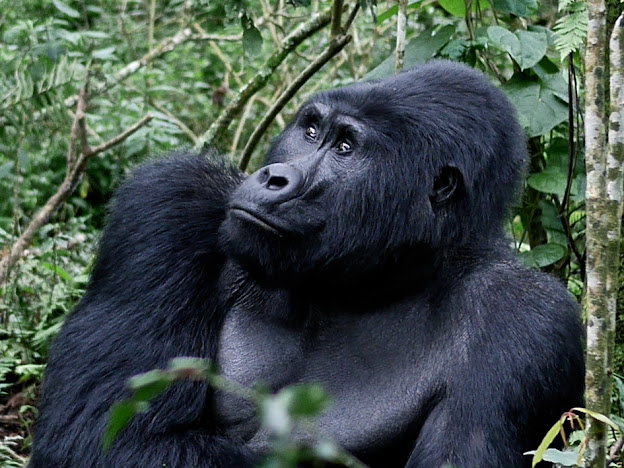
His two year-old was a different story altogether. He bounded about the clearing with hardly a moment’s stillness, jumping to grab a low branch and swinging and twisting wildly. He charged at us, with as much fearsomeness as he could muster, quickly thumping his little chest with his hands in mid-run. It would have seemed much more fearsome it he hadn’t stumbled over a root and fallen onto his face during the chest thumping. He didn’t see us as any kind of threat and he wanted to play. Our guide had to shoo him away with a branch so as not to have us make physical contact with the little fella.
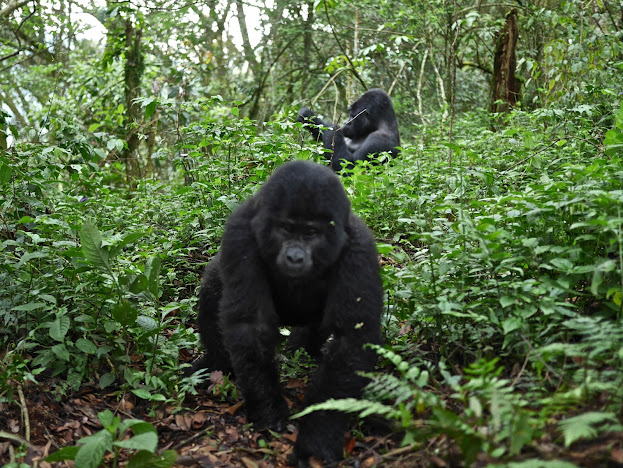

In total, we spent an hour with the furry primates that passed by in a flash. I spent most of the time squatting in the bushes about 6 meters from the silverback staring in wonder at this enormous, powerful creature that had such an air of peace about him. This was all Jamie’s idea and looking over to see the excited smile on her face as she peered through the foliage felt grand. In the afternoon we descended back to our camp, slipping down slick spots on the muddy trail to land on our backsides and describing this or that moment of the encounter.

Only about 880 of these mountain gorillas remain in the world, all of which live in the rainforests of Uganda, Rwanda, and the Congo. Parks like Bwindi, which was designated as a World Heritage Site in 1994, are the only way their habitat has been preserved and are essential to the continued survival of the mountain gorillas. Some 30 gorilla groups roam Bwindi Forest, 10 of which have been habituated to humans by the rangers and trackers. so that they . This process of habituation takes 2 years and results in the gorillas viewing humans as a neutral species that mean them no harm.
Constrained by the rains, we took two days in transit from our mountain camp to Kampala. The day we left, a long menacing black cloud loomed in front of us by 10:30 AM and within 15 minutes it descended on us with fury. We only had a few minutes to seek out some shelter and found a wooden shack at the perfect time to weather the worst of it.
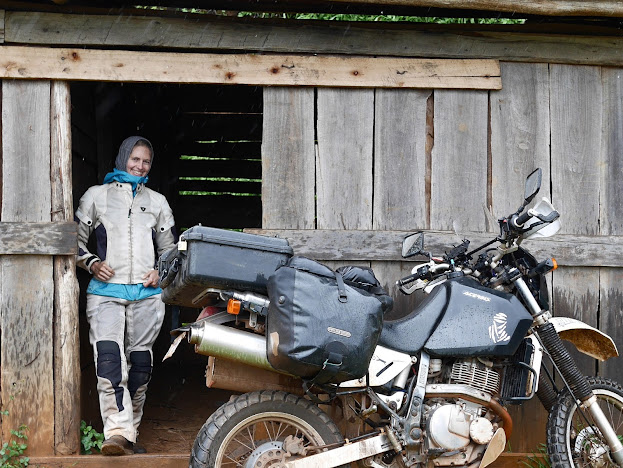
Despite the storm, it only took the local village kids a few minutes to find the Mzungus huddled in the shack. After some wary staring from the opposite side of the road with Jamie smiling back, they decided on bartering as the mode of interaction. The first brave soul ran halfway across the street and threw two potatoes in the grass in front of us. The next one came all the way over to us and handed two more to us. In exchange we produced a few coins, which turned on the potato tap. We ran out of coins we gave up a carton of milk, a bracelet, and a pen. Somehow the message that we don’t want any more potatoes didn’t seem to be coming across.

By the time we were out of things to give and the kids finally gave up, we had a stupid amount of potatoes to carry away.

As we dropped altitude, Dyna Rae ran a bit smoother and the rainstorms didn’t last quite as long. The only important reason we had for coming into Kampala was to visit the Sudan embassy and try once again to procure a visa. After a couple hours wait, still all geared up, we were allowed to meet with the very friendly ambassador who gave us the same story we’d received in Nairobi: visa approval for US citizens must come from Khartoum, which could take a month. Since we’d already been denied a visa in Nairobi per this process, we decided it best to move on and wait until Addis Ababa, Ethiopia, where this ambassador said we should be able to obtain a transit visa. Strike two. We get one more swing at this in Addis before we’ll need to get creative.

Approaching the seething capital of Kampala turned out to be another mad riding affair. Big surprise, I know. I should really be used to it by now, but I still get pissed when getting run off the road by an oncoming truck. Which happens at least 30 times in a day in Uganda. Just three days before our arrival in Kampala, we got some very sad news about an Australian couple on a BMW1200 GS that had a crash along the same route we were riding. Like Jamie and I, Dean and Tanya were in their 30’s, and had tossed in their jobs to travel the world two-up on a bike. A four-wheel drive truck overtaking another vehicle ran into them head-on, killing them both. They had big dreams and plans to tour the world on their bike. Their website is titled “ Once Life is all You Get” and a quote above one of their photos reads:
“The most dangerous risk of all: the risk of spending your life not doing what you want on the bet you can buy yourself the freedom to do it later.’’
It’s difficult to reconcile people’s general warmth and regard for one another here with the madness found on out on the road. No true adventure comes with a guarantee of safety, but we like to think that we’ve got our eyes wide open to the risks. We kept calm and carried on.
We stayed on the outskirts of Kampala for a couple nights before fled the chaotic city eastward to the banks of the Nile. We stayed at a camp just where the mighty River drains from Lake Victoria.
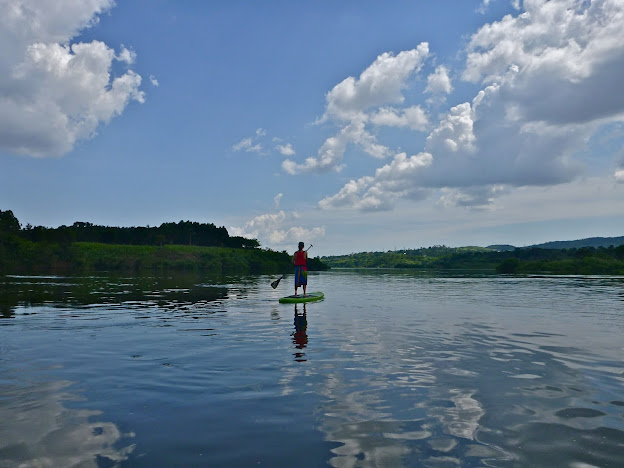
We hired some paddleboards from the camp and began our explorations upriver. The current wasn’t swift, but it was some effort to resist it washing us downriver.

We explored little islands in the middle of the river and I found a rope swing for an aerial assault on the Nile. In my underwear.

The next morning we loaded up after a morning rain shower to ride eastward back to Nairobi. We’ve been riding for a month now circling Lake Victoria, visiting three new countries and crossing the equator twice. It’s been an action packed few weeks and we’re now headed back to the city that’s become more familiar to us than anywhere else on the road. We plan to regroup there and do some bike maintenance before beginning the long journey into north Africa, keeping our eyes wide open.

|

15 Nov 2014
|
 |
Registered Users
Veteran HUBBer
|
|
Join Date: Jan 2006
Location: Yuma, Arizona, USA
Posts: 548
|
|
|
Wow, the gorilla encounter looked like right out of Nat Geo!! Of course, your humor comes in at the right time "...Sounds reasonable, 700 pound gorilla closing fast, just stay cool, continue grunting ‘ooo…ooo….ooo’ and munching my palm leaf."
|

28 Nov 2014
|
 |
Registered Users
Veteran HUBBer
|
|
Join Date: Nov 2010
Location: Santa Cruz, California
Posts: 316
|
|
|
Hunting the Wolves of Bale

The Ethiopian wolf is the rarest canid in the world, with less than 500 individuals left, most of which live in the country's southern Bale Mountains. We hoped to glimpse this uncommon beast in its home environment but before we got there, Ethiopia had some trials lined up for us. 
It was an hour before we broke free of the city traffic as driving north out of Nairobi headed towards Mount Kenya. Our friends and fellow moto-overlanders Ash and Deb, were staying with some expat friends near the town of Nanyuki and invited us to stop over for the night, so we made our way down the slippy-slidey muddy track to their cabin. On the way out the next morning, they gave us a tip of where we were likely to catch sight of some rhinos right by the roadside and sure enough we spied a group of 4 of them after just 5 kilometers of riding.
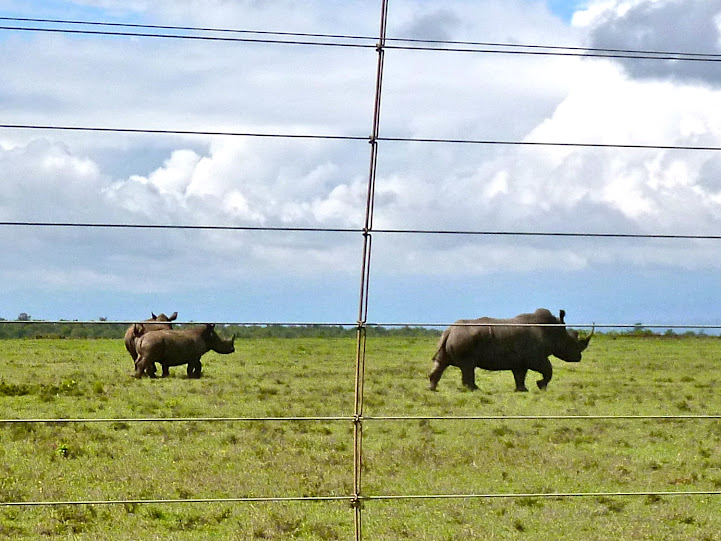
In the north of Kenya, the rivers began to shrink and then finally dried up completely. Herds of camels appeared around every turn and for a time it felt as though we’d already entered an Egyptian desert scene.


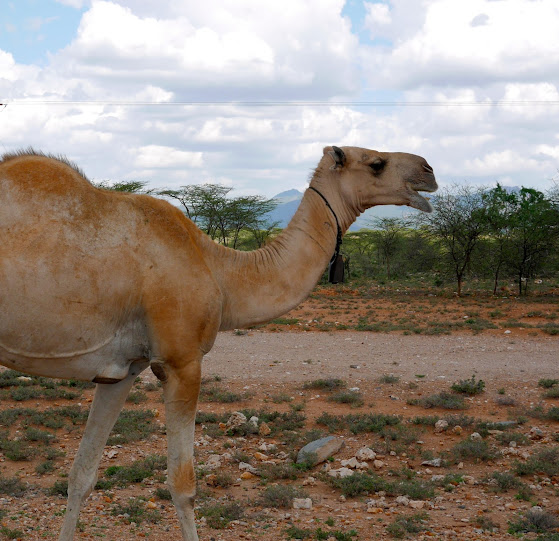
The desert-scape was a welcome change of scenery after months of riding through lush jungles and camping in the rain, but made for less than ideal picnic spots.
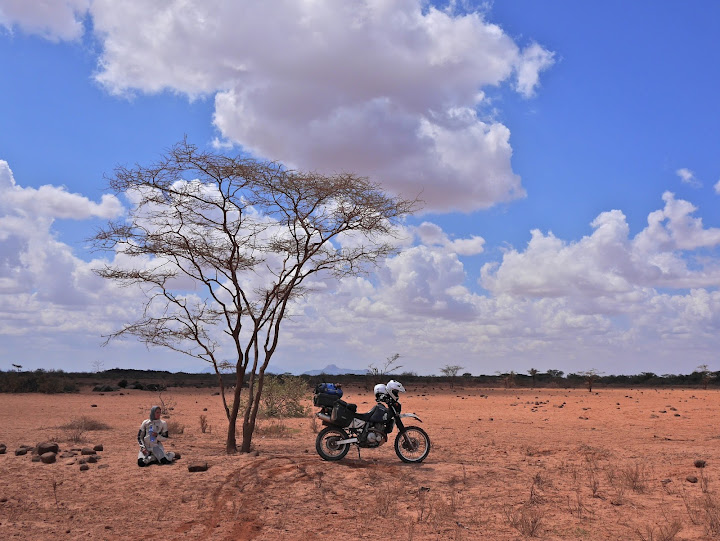
As abruptly as the landscape had dried up, moisture and green hills returned and the landscape erupted before us with vertical red walls towering overhead.

When Jamie starts photo-bombing pictures I know that I’ve probably taken enough photos of the same rock.

As we zipped along on the freshly laid tarmac, a fellow traveler appeared to remind us how quickly we’re able to cover ground on our motorbike.

This was desolate country and other than our slow-footed friend, we rarely passed anyone. Other vehicles were usually military or road construction trucks.

We drove out on a random sand track headed into the hills to find an eco-camp of sorts that we’d learned about from Ash and Deb. When we stopped the bike to look around the camp, I found that the bike didn’t want to start and found gas coming out of the carburetor overflow. When I opened the carb drain screw, gas drained out far longer that it should have indicating that nearly the entire carb was filled up with gas rather than just the float bowl. It was clear that I needed to work on the bike, and I have tendency to break things when I try to fix things, so we headed out of the hills and back to the last highway outpost for the night.
The float bowl on the carb is just like the tank on a toilet, as it fills, it pushes a float upward that is attached to a lever and a valve to shut off flow when it reaches the correct height. Since the carb was over-filling with gas, it goes to reason that either the float was getting hung up, or the valve wasn’t sealing properly when the gas reached the correct height. I removed the float bowl and checked the o-rings and float needle. This little guy is what blocks off the flow of gas in the carburetor.

The float needle looked fine, so I replaced both o-rings on the float, put everything back together, and hoped for the best. The new o-rings seemed to do the trick and I’ve had no more carb drowning incidents since. Back on the road, we knew that the perfect tarmac couldn’t last forever and when it finally disappeared the road turned to alternating sections mud bog and rough rocky stretches that slowed our pace to a crawl.

The last miles to the Ethiopian border shook us to the bone. Jamie’s knees were about spent from trying to maintain her position and getting launched in the air when I hit a big bump at speed. I could feel the punishment that poor Dyna Rae was taking beneath us, and I winced at every hard impact as though I were taking it straight to the chest. After being checked for signs of Ebola virus yet again by a medic at the immigration post I went into the customs office. Our research indicated that a temporary import permit should be no problem at the border, so I wasn’t worried about the fact that the Carnet for the bike had expired 4 days ago. However, upon the absolute insistence from the customs folks that the bike could not enter without a Carnet, I produced the document from my folder hoping that they didn’t notice the expiration date. Every new staff person that the Carnet was handed had me sweating a bit more. All that need happen was one pair of eyes to notice the expiration date, printed in bold red letters on the cover and on every page of the document, and the jig was up. Amazingly, they handed the document back with a stamp and a smile. I smiled back and let out a sigh of relief that we could get on our way. Unfortunately, they used up the last page in the Carnet, so I wouldn’t be able to test my luck again in Sudan or Egypt, which also require a Carnet.
I walked out of the customs office to find Jamie holding the bike in an awkward position, as she had had to move it to make way for an exiting truck and now had it standing precariously upright. I looked down to see the rear tire sadly squished flat to the ground. She was a beast to move fully loaded with a flat tire as we grunted it up to flat ground. Then it started raining. It became clear that we would be spending the night on the Ethiopian border.

The next morning I got to work on the bike and found that the hole had resulted from a fold in the tube that must have pinched during one of the hard hits we took the previous day.

After finishing a artfully crafted patch job on the heavy-duty tube, I found that the valve stem had delaminated and was leaking. This slow leak must have been what allowed the tube to deflate enough to cause a fold. After a failed attempt to repair the valve, I installed the spare standard-thickness rear tube I had been carrying since Cape Town. Perfect timing - we’d just left Nairobi, the one place where I could probably find a 17’’ heavy duty tube between here and Europe. I suppose I should really be counting my blessings though, since this is the first puncture I’ve had on the entire trip and it didn’t happen in the middle of a cooking desert. I re-greased the wheel bearings for good measure (still original at 48K miles!), and we were on the road into Ethiopia.

Since I’d spent ages fixing the bike that morning, and the road turned out to be a radical mess of asphalt craters, we didn’t make it very far into Ethiopia. There seemed to be more pothole surface than actual asphalt surface, so that even on a motorbike moving at less than 20 mph, I couldn’t avoid them all. The rim bending, flat making minefield of square edged holes led us to a guesthouse in a tiny little town called Mega where we immediately gathered a colossal crowd of curious kids. In fact, all throughout the ride, we’re met with constant calls of ‘You! You! You!’ , which seems to have replaced ‘Mzungu!’ as the standard white folk alert to the village.
We are in the middle of the dry season for Ethiopia, but you wouldn’t know it from the soaking ride that we endured the next day. We were lucky at the onset of the first downpour, happening upon a church overhang in a very friendly village just as the heavens opened up in earnest. The church was constructed of hay bales and mud and most of the little village crowded under the overhang with us. No one spoke any English so we pretty much just smiled at one another, the kids touched the armor in our jackets, and everyone seemed happy to wait out the storm with us.
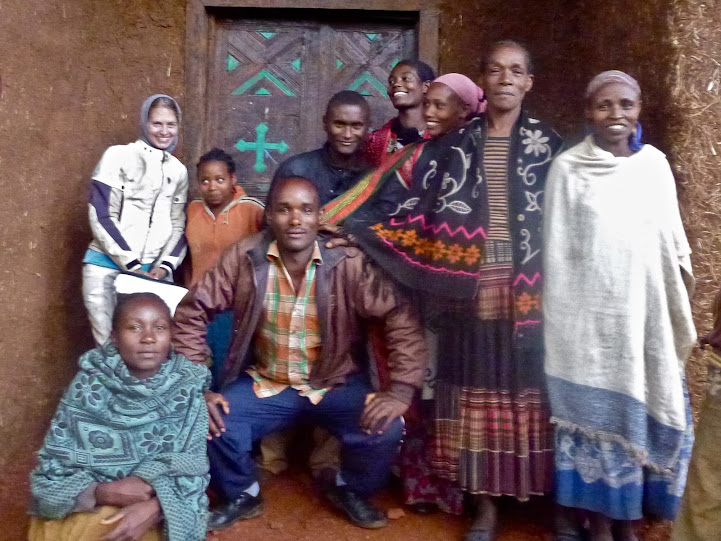
We weren’t so lucky for the next downpour and before long I was soaked to the skin and shivering in my jeans while Jamie fared a bit better in her moto pants. The road got even worse and my visor kept fogging so I had to keep it up and could hardly see the tangles of treacherous potholes before were bounding straight into them. The destroyed asphalt sections alternated with stretches of mud with dubious traction. I was getting incredibly frustrated at my inability to see what was ahead and feeling that a fall was imminent. I swore loudly in my helmet as the driving rain stung my cheeks like needles and Jamie tried to hang on behind me. It just went on and on like that as darkness began to fall and there was just nowhere to shelter so we had nothing to do by keep going.
I turned to focused silence as my shoulders cramped and stiffened until they felt like the craggy, gnarled branches of an old oak tree. We came upon a truck that had slid sideways off the road, completely blocking passage as another truck tried to pull it out the ditch. As darkness fell we managed to snake our way through the muddy carnage of the trucks into a small town where Jamie spied a place that we could finally stop. We’d found a guesthouse where we could shelter for the night. The place was absolutely infested with cockroaches that weren’t the least bit shy, but we didn’t care – it was a roof with dry space beneath it.
The next day we ascended into the highlands to find vast plains where villagers cultivated vast fields of wheat and tended livestock. I never would have imagined a scene like the golden undulating hills of wheat existed in a place like Ethiopia. Riding was slow as the road had few motor vehicles but was absolutely filled with horses, donkeys, goats, cows, and people. There were hardly any bicycles or motorbikes. We were in donkey country where the most common way for moving people and goods is a cart with wooden wheels drawn by these shaggy, sullen-eyed braying beasts.
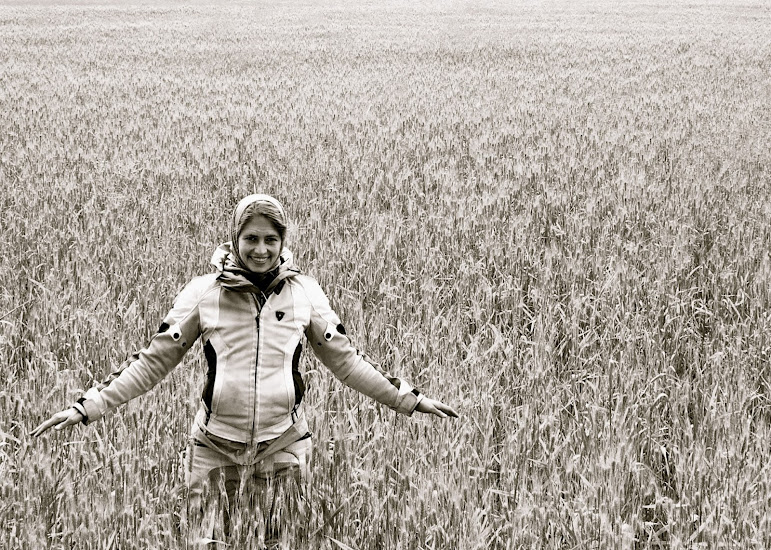
As the day wore on we rode higher and the landscape became more dramatic around us. We found a simple guesthouse for the night in the town of Goba and prepared to continue our ascent onto the Senetti Plateau in the morning in the hopes of glimpsing a wolf or two prowling the high country.

The morning gloom was thick as we mounted the bike for a ride into the clouds. As we powered through a few mud bogs in the road I was glad that I’d changed to a 14 tooth front sprocket shortly after entering Ethiopia, gearing the bike lower than the stock 15 tooth front sprocket.

As we climbed, we were flanked by sheer escarpments of pink-orange rock to either side of the vast plateau that makes up the largest area above 4 thousand meters on the entire African continent.

We motored on through the gloom, with the air temperature dropping as we ascended. We stopped to stalk through the low vegetation of the boulder-strewn plateau keeping a keen eye out for any signs of a wolf and spied a number of endemic raptors perched on boulders.
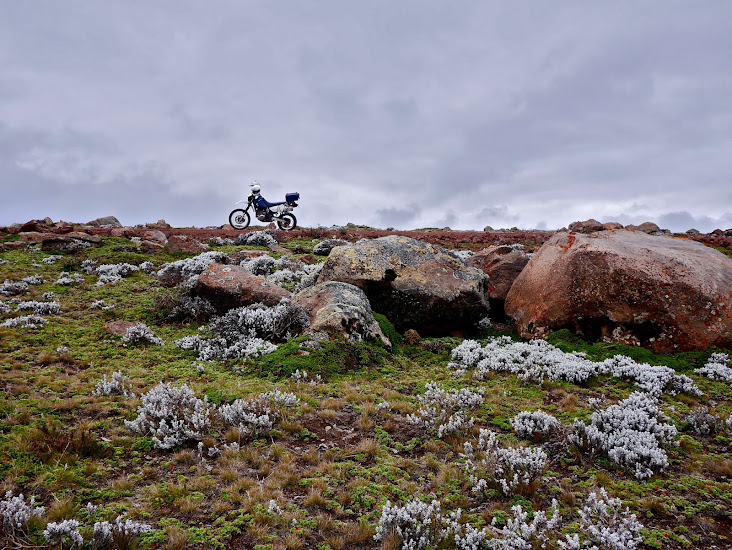

Being a long way from any surf, and not having any discipline whatsoever, I don’t do any exercise to speak of. Instead, I like to strike athletic high altitude photography poses. This is the most strenuous physical thing I’ve done in two months. Seriously.

We turned off the main road to ascend the highest part of the plateau up a rocky rutted track and finally climbed to a height of 4,400 meters (that’s 14,500 ft). Of course when I say climbed, I mean we sat on our butts while I moved my hands around a little bit.

This the highest I’d ever ridden the bike and wondered whether or not she would make it without choking badly in the thin air. Somewhat to my surprise, she thumped right along without issue all the way to the top. The decent was a bit gnarly, so Jamie decided to take control.

By the time we moved on to our most likely location for spotting wolves, the weather turned ugly. A thick cloud enveloped the plateau and the temperature continued to drop. Then it started to rain. We’re in the middle of the dry season in Ethiopia and it dumps rain every day. I must remember to write a letter to the ministry of tourism to complain. Before long were soaked through.
For the cloud we were now inside of, a wolf would have had to come up and lick our faces to spot one. We still had an hour and a half to ride before we would descend the plateau, so we threw in the towel on the wolves and turned around. Before we got down Jamie and I were both shivering. I had to stop three times to warm my hands on the engine as they became frozen into ineffectual claws on the handlebars. My visor kept fogging up and the road was strewn with rills and holes, so I kept my it up, freezing my face all the way down.
In the southern highlands of Ethiopia we’ve found incredibly friendly people, trucks that don't run us off the road, a sea of donkeys, a bit of bike trouble, an absence of super special wolves, and more rain that we’d bargained for. Despite a few challenges, Ethiopia has already charmed us.
|

28 Nov 2014
|
|
Registered Users
Veteran HUBBer
|
|
Join Date: Feb 2012
Posts: 836
|
|
Thank you for sharing your journey!
It alway nice to see an update here 
Surfy
|

7 Dec 2014
|
|
Registered Users
New on the HUBB
|
|
Join Date: Aug 2014
Posts: 16
|
|
|
Hi
Will you come to Spain in the future?
|

15 Dec 2014
|
 |
Registered Users
Veteran HUBBer
|
|
Join Date: Nov 2010
Location: Santa Cruz, California
Posts: 316
|
|
|
hey Victor - I'll not pass thru Spain on the way back..sorry to miss meeting a fellow HU rider!
|

15 Dec 2014
|
 |
Registered Users
Veteran HUBBer
|
|
Join Date: Nov 2010
Location: Santa Cruz, California
Posts: 316
|
|
|
Riders of the Lost Ark

As expected, arrival in Ethiopia's capital city of Addis Ababa was a chaotic affair.  But at least it is a gentle chaos, with everyone launching into intersections, creating an auto-quagmire, but then slowly and carefully nudging forward or finally giving way when inches away from the fender panel of a larger vehicle.
Fixing Sudan
Our primary objective in Addis was to obtain a transit visa for Sudan, as we’d already been denied in both Nairobi and Kampala due to our citizenship in the good old US of A. The embassy in Addis was our final hope for a visa.
Our hopes deflated when upon arrival at the overlander-frequented Wim’s Holland House, a Dutchman told us that the last two Americans seeking a visa to Sudan were summarily thrown out of the embassy. While we managed not be restrained by the ambassador’s goons, we were denied all the same, informed that they required an approval from the foreign ministry in Khartoum to give us a transit visa. We contacted tour agents and hotels in Khartoum who seemed to be willing to apply for an approval on our behalf, which may have been helpful, but it would take two weeks cost us $300 on top of the $200 each it was going to cost to apply for the Sudanese visa. In Nairobi we had been denied approval from Khartoum after a two-week wait, so we weren’t anxious to go down a similar path here. We visited the embassy 4 more times in the next three days, each time waiting patiently for hours and respectfully requesting an audience with the Consul to present our case, but were turned away each time.
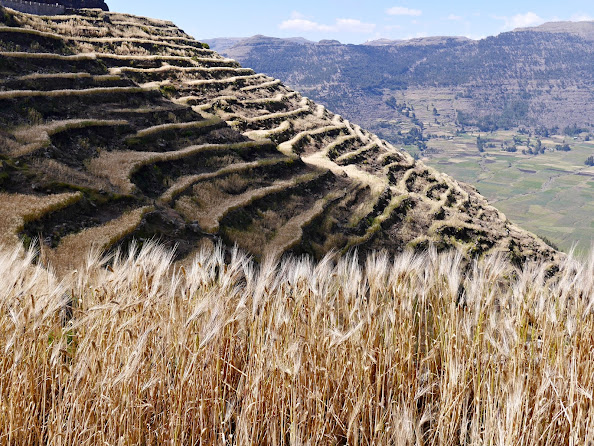
Things were looking grim. We started making inquiries on getting a boat from Djibouti up the Red Sea. The waters were said to be thick with Somali pirates, but our options were narrowing, as there is no land route for us around Sudan. Then we got in touch with a ‘fixer’ and tour operator in Khartoum called Midhat Mahir, who told us that he knew the Consul well and that he could vouch for us. Unfortunately we never managed to get past first line of defense to get this information to the Consul.
On the fifth day at the embassy I enlisted the help of a Sudanese guy waiting with us who helped convince the embassy front-window staffer that our plight was worth interrupting the Consul for a moment. Within minutes of sending the staffer back with Midhat’s card, he returned and agreed to process a transit visa for us. It was amazing. A minute before a transit visa was simply not possible, even armed with a sworn affidavit from the United States Consul in Nairobi, a letter of invitation from a hotel in Khartoum, and a valid Egyptian visa already in our passports. And an instant later it was no problem. I suppose that’s what a fixer does; he fixes stuff. I couldn’t believe that after a week in Addis, half a dozen trips to the embassy, and copious hours on the internet researching options, we finally had our ticket north.
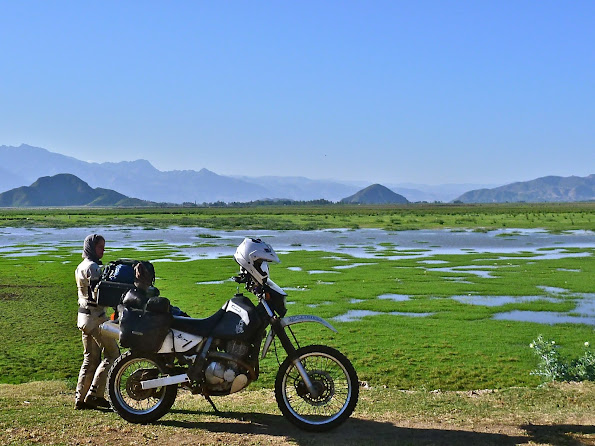 Exceptional Ethiopia
Exceptional Ethiopia
Ethiopia has it’s own language (Amharic) with its own alphabet, its own calendar, and its own time keeping system, all of which are unique in the world. It all can seem a bit mad to travelers; the time is 6 hours ahead of what the rest of the world would suppose, and the date is about 7 years behind the current Gregorian calendar year. It’s 2007 again. I feel younger already.
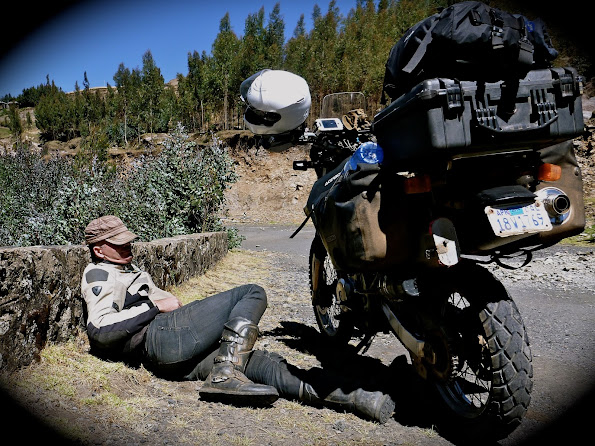
Perhaps the most defining characteristic of riding a motorbike in Ethiopia is the omnipresence of animals and people occupying most of the road. Riding a motorized vehicle, we felt an interloper more often than not, interrupting the endless drive of goats, sheep, steer, camels, and donkeys. Usually, I ride nearly in the center of the road to avoid the throngs along the side and one time I was nearly clotheslined by a gang of camels walking abreast who were roped together. The animals are always going somewhere. I was under the impression that they mostly keep their faces in the grass eating all day, but these animals seem to keep very busy schedules. It’s hard to be in Ethiopia for a month and not want to own a Donkey. Camels not so much.
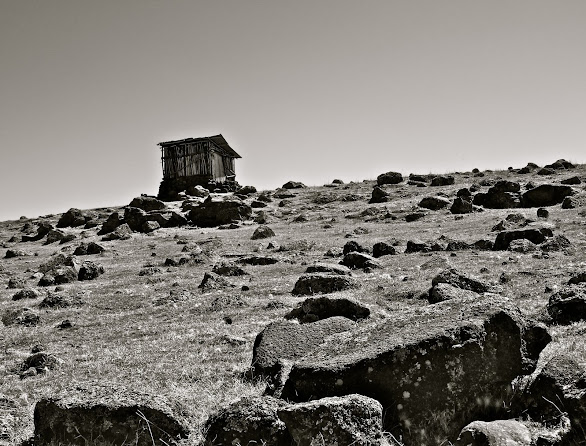
For all of its idiosyncrasies, Ethiopia is a great place for independent travelers, with incredibly affordable accommodation and tasty food. In the town of Wereta, we found the cheapest hotel yet - deluxe accommodation at the Hotel Obama goes for just 14 Birr or $0.70 USD. We decided to splurge at a hotel up the road for a whopping 60 Birr ($3 USD), but unfortunately found later that night that the hotel was also the local brothel and dudes were in the mood for love.
Christian rock
On the way north, we hit a long stretch with plenty of petrol stations, but no petrol. There isn’t much traffic on the road here and most of the vehicles are big trucks and buses that burn diesel.

We ran on the reserve tank for only a few miles before finding fuel, but that was enough to suck whatever gunk in from the last petrol I’d gotten out of dodgy barrel in a village into the carb and clog the inlet filter. Dyna was bogging under any more than a quarter throttle as we limped into a guest house for the night where I could clean her out.

The dramatic landscape of Ethiopia seems to stretch on and on, with steep valleys and mesas undulating to the horizon. Swiftly flowing rivers are strewn with cobbles and boulders, with hardly a grain of sand or silt to be seen, indicating a channel most accustomed to powerful high flows.
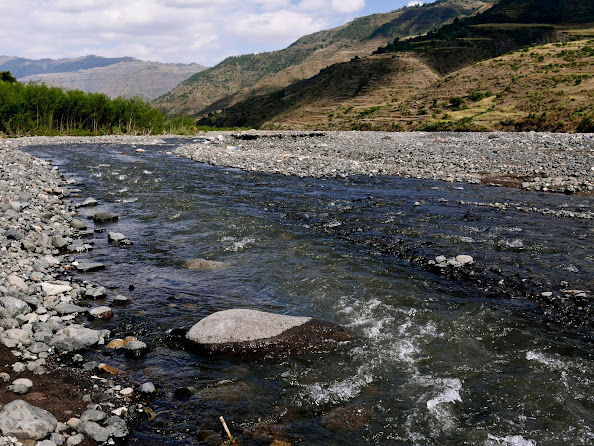
We made our way along 40 miles of gravel road to the town of Lalibela to find the churches that we’d heard so much about. It’s one of those places that everyone says you must go. After so much time on the road, I don’t readily take such recommendations to heart, but we blown away by what we found there.

Walking out onto the volcanic rock that flanks the town, we found the massive, ornately decorated structures hewn straight from the rock.
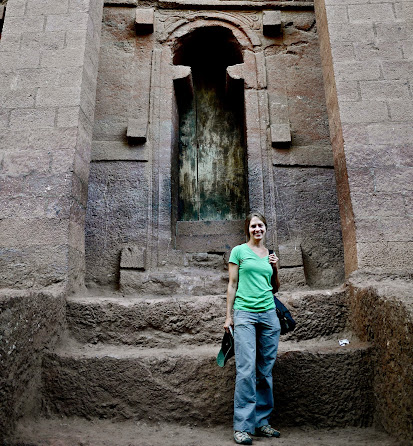
It was incredible to think that all of the space that we walked through, both adjacent to and inside the buildings was once occupied by solid rock. It’s hard to imagine having the notion to start carving these things out from a plain mound of basaltic rock on a hill.
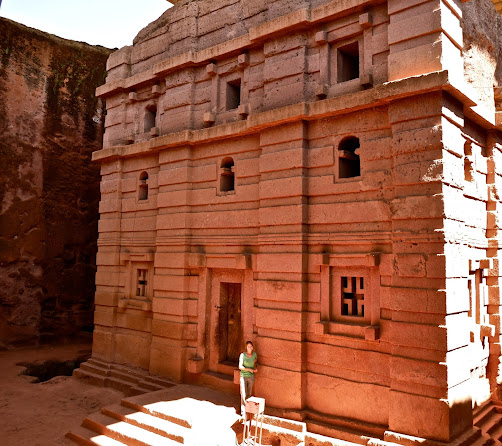

The churches were constructed during the 12th century during the reign of King Lalibela (or at least partly so). One historical legend holds that king Lalibella wanted to create another Jerusalem so that pilgrims wouldn’t need to make long dangerous journey to the holy city.

We wound our way through the networks of subsurface tunnels connect more the 15 buildings in the area. These aren’t just relics, but functional churches, still regularly occupied by priests and worshipers of the village and a destination for thousands of pilgrims for centuries.
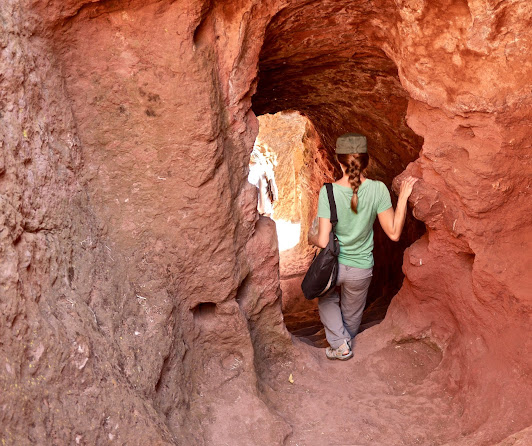


The churches of Lalibela were truly awe inspiring and it's no wonder that this place was designated as a UNESCO world heritage site.
Gondar not Gondor
On the way out of Lalibela, we met with more of the fantastic landscape of the region, reminiscent of the canyon lands of the American southwest.
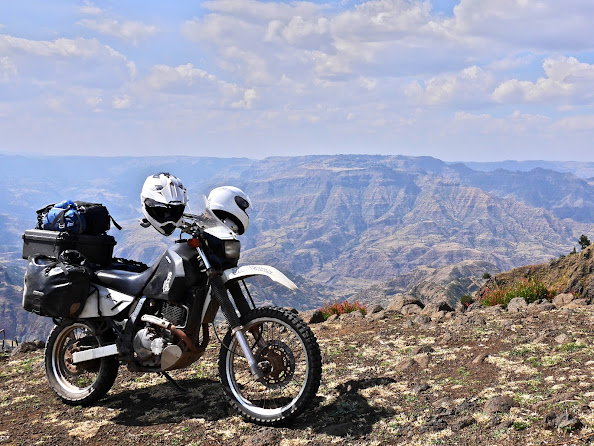
When we stopped to admire the view, Jamie quickly made some friends eager to practice their few words of English and invariable ask for a pen.
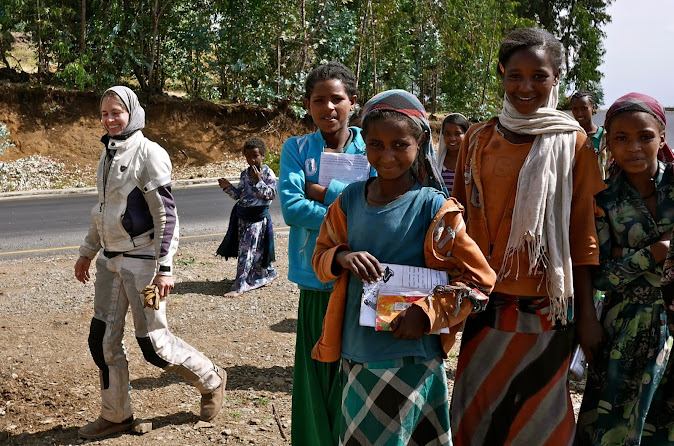

Similar in name to a certain city of Middle Earth, Gondar also has fantastic castles of old, but seems to be ruled by tourist guides rather than horse lords. The Ethiopian Emperor Falicidades made Gondar his seat of power in 1636, constructing magnificent palaces, beautiful gardens, and grand churches. We wandered through the ruins back into the 17th century and tried to imagine what life would have been like for those dwelling within the castle walls.


It was a fantastical place and we seemed to have it all to ourselves as we tried to find stairways up to the tallest towers of the different castles. It was fun. Jamie gave a smirk of approval.

Some of the castles were built centuries apart from one another and were in various states of ruin or preservation.

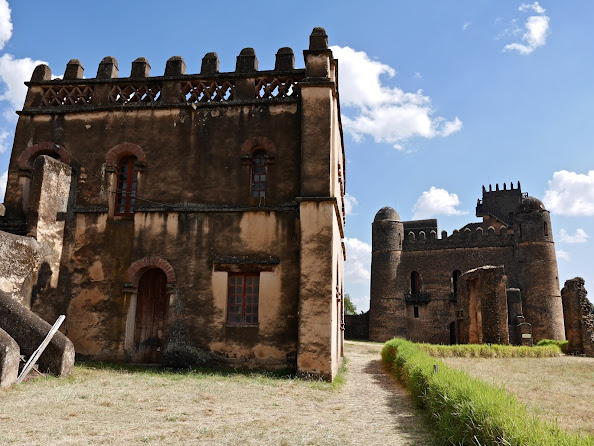
 Holiday activities
Holiday activities
We had big plans to hunt down the legendary Ark of the Covenant that supposedly lies just to the north of Lalibela in the town of Aksum. What better way to spend the holidays than laying eyes on a physical piece of biblical history, right? The Old Testament says that the Ark of the Covenant was built by Moses on Mt Sinai and contains the two stone tablets with the Ten Commandments inscribed on them. The Ark lived in King Solomon’s Great Temple, which was sacked in 587 BC, when the Ark disappears from mention in the Old Testament. Ethiopian tradition holds that it was brought to Ethiopia sometime in the 1st millennia AC by Menelic, son of Solomon and Sheba and now sits in the inner sanctuary (the holiest of hollies) Aksum’s St. Mary of Zion Church.

Unfortunately the holiest of hollies turned out to be too holy for us. We learned that they keepers of the Ark don’t even let foreigners in to the parking lot of the church ever since some tourist tried to rush the gates in their zeal to set eyes on the relic. Sorry to disappoint, but these riders can’t weigh in on the authenticity of the ark in question, let alone its ability to melt the faces off of would be raiders.

|

15 Dec 2014
|
 |
Registered Users
Veteran HUBBer
|
|
Join Date: Nov 2010
Location: Santa Cruz, California
Posts: 316
|
|
|
Riders of the Lost Ark 2
Forging ahead
We retreated to Dutch owned enclave called Tim and Kim’s Place on the shore of Lake Tana (the source of the Blue fork of the Nile) at the end of a long dirt track. Jamie did some washing and I did a bit of work on the bike to prepare for our launch into the Sudan. Dyna Rae got some new shoes for the back brake, her cables lubed, and a few seized bolts liberated with lots of patience and persuasion on my part. If ever I spend so much time on a motorbike in the rain again I will surely be more generous with the WD-40 to preemptively combat corrosion.

We already had our Sudan visa in hand, but the problem was securing passage for the bike since my Carnet de Passages is now expired and also out of pages. We’d managed getting into Ethiopia on the expired Carnet (probably because the Ethiopian calendar says it’s 2007), but greater proximity to Europe means more stringent customs regulations. By all accounts the Sudan bureaucracy has the immovability of an ill-tempered camel.

I used a scanned copy of one of the last blank Carnet pages to create some new ones that I edited to read Nov 2015 as the expiration date and obscured the date on the front cover. I carefully folded the printed pages along the lines of where the perforations of the genuine document would be and Jamie meticulously unbound the Carnet to insert the new pages.
After all of our careful work we had a forgery that was laughably easy to detect. With southbound overlanders invariably reporting a Carnet was required to enter Sudan with their vehicle, our options were few, so we figured it’s was a shot.
|

18 Dec 2014
|
|
Registered Users
HUBB regular
|
|
Join Date: Nov 2013
Location: Key West, Florida
Posts: 26
|
|
|
Travelers who wig out about forging documents to get the job done make me crazy. I've showed up at the DMV where they needed my wife's signature. "Hold on a minute" I said and went out to her "...in the car." A minute later I was back with her signature...on the dotted line.
Your story so far should be required reading on how to cross borders.
Good luck.
|

27 Dec 2014
|
 |
Registered Users
Veteran HUBBer
|
|
Join Date: Nov 2010
Location: Santa Cruz, California
Posts: 316
|
|
|
Sudan on the Sly

After two days at Lake Tana, fuel finally arrived in Gonder at one of the half-dozen petrol stations that we stopped at. There are plenty of petrol stations in Ethiopia, but not much petrol.  We descended from the high plateaus of Ethiopia into the desert flats of Sudan and felt the cool air on our faces turn to a hot dry blast.

Coming from Ethiopia, we couldn’t help but ask one another: “Where did all the donkeys go? “ and “Why aren’t there people jumping in front of me on the road?” Sudan is mostly desert and a sharp contrast from the continual roadside village in the highlands of Ethiopia.
 Persistence
Persistence
At the Ethiopian immigration office my passport wouldn’t scan using their special little passport scanny machine. The first guy checked all of the connections of the machine, turned it on and off 4 times, and then tried three different computers in the office to no avail. When he lost interest, the next guy went through he same process. A woman appeared next and repeated the same process again. Each time, the person who’d previously attempted to scan my passport and failed never said anything to the new person trying to do it even though they were sitting right next to each other. After about an hour of this routine, my passport finally returned back to the original guy who after a few more tries finally seemed to resign himself to typing in the 6 fields of data manually. It took 5 minutes.

The moment of truth came at the Sudanese customs office, when our forged Carnet document was to be put to the test. The customs guy was mellow and I kept him chatting the whole time. I figured the less time he spends staring at our document, the better. I heard that lovely click of a stamp placed on the Carnet and we were sent on our way with a smile. It felt like sneaking into a movie theater when I was twelve.
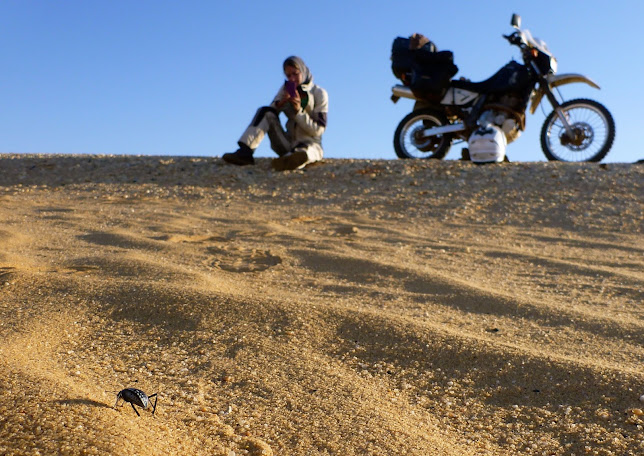
We blazed into Sudan, bush camping the first night near a watering hole and were woken to a herd of cattle being led to the water after dark. Lulled to sleep by the cattle moo’s, we woke to break our fast on apples with peanut butter and oranges.

Once in Khartoum, we needed to register our passports with the immigration office, which sounds like a simple thing to do, but a very grumpy lady made it pretty difficult. After waiting for an hour to simply hand our passports, application, and photocopies of our visas to her, she handed them back indicating that she would like the pages unfolded and inserted to the passport rather than folded in half. She went on to help some of the other throng of people with their arms jutting in front of me while I unfolded the pages. When she decided to collect ours again 20 minutes later, she scrawled something in Arabic on them and handed them back. I had no idea what had just happened. We were at the Khartoum Airport foreign passport registration office, but of the half dozen people behind the counter, not one spoke a word of English (which is a national language of Sudan). I went off to another office and found a girl who spoke English to help us out. Apparently this lady was saying that we needed to have a Sudanese national complete this registration for us. We were at a loss since we didn’t actually know anyone in Sudan. It seemed utterly ridiculous since this registration was required of all foreigners and would cost us $45 each to boot. After half an hour of discussion someone else decided to process the registration and we were finally on our way.

Our next task in the labyrinth of Sudanese bureaucracy was to obtain a permit to travel beyond Khartoum and to take photos while in Sudan. This turned out to be much easier than the previous task once we found the correct office. Nonetheless, we’d had our fill of Sudanese red tape and were happy to get on the road back into the desert.
Tomb Raiders
We headed north the Pyramids of Meroe – the site of a royal burial ground that dates back to the 8th century BC. There was no one else there and we couldn’t help but feel as though we’d discovered something amazing as we made fresh tracks on the dunes surrounding the tombs.

We appreciated the privacy.
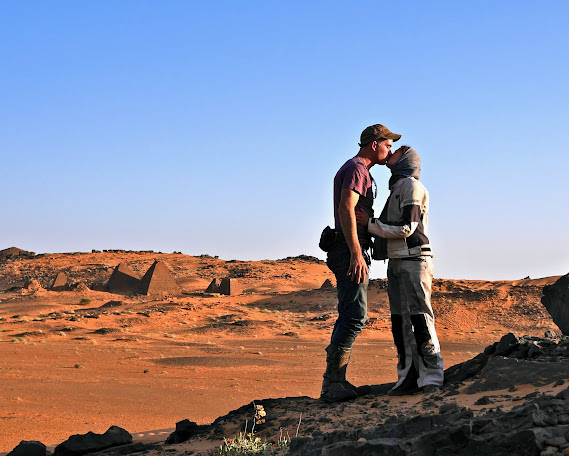
The unfortunate destruction of the pyramids was apparently primarily the work of a single insatiable Italian treasure hunter who took the tops off of most of them looking for gold.

Inside of the tombs were carved pictures illustrating the lives of people who lived and died in this desert thousands of years ago.
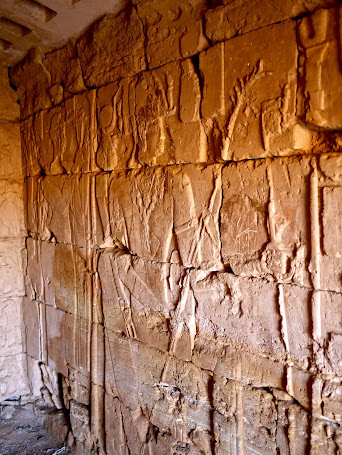

Jamie dismounted and Dyna made a major effort to power up the sand to find a fantastic campsite perched on top of the dunes in view of the pyramids as the sun touched down.
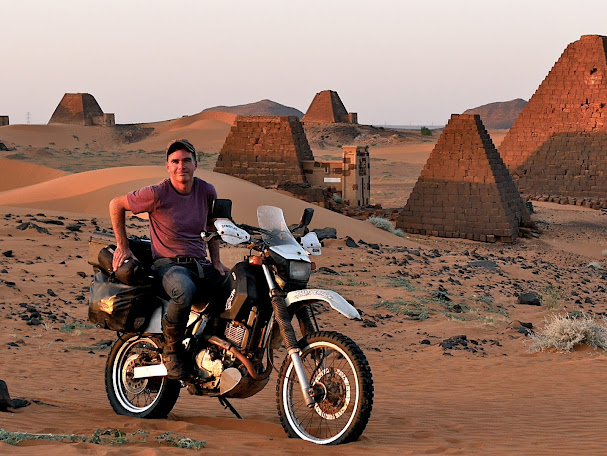
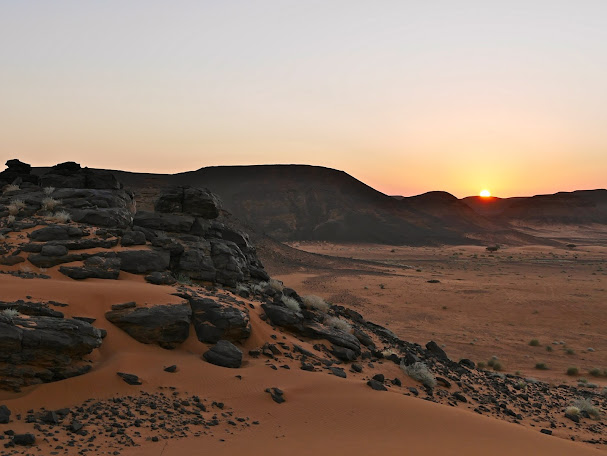
As the sun poked above the surrounding hill a golden glow was cast across the scene of one of the most astounding campsites we’ve had the entire trip.

The only person that showed up the whole time was a man who trotted up on his donkey.

We got underway the next morning and came upon more of the tombs built in similar style to those in Meroe that we’d never even known about.
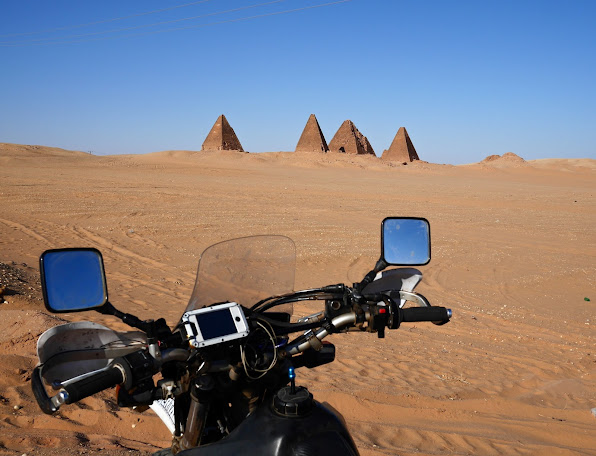 Dinner Guests
Dinner Guests
By our second night bush camping, things were looking a bit ugly on several fronts. We didn’t have enough gas to make it to the border town of Wadi Halfa, we’d just put the last cash we had in the tank, and to cap it all off, the front tire had seen better days. Eight thousand miles and lots of donkey-cart-induced hard braking had taken their toll on the Kenda Big Block tire, which now showed patches well below the wear indicators. At every stop I neurotically checked the low spots for signs of steel belting wearing through and wondered how far we would make it.

None of our problems were going to be fixed in the middle of the desert, so we just made dinner and watched the first stars start to beam through the fading light of the dusk.


Just after sunset, as I was cooking dinner a Land Cruiser turned from the highway and make a b-line straight for us, bouncing along the desert plain, kicking up a cloud of dust behind it. We were camped about a kilometer from the highway on a flat, hard packed flat and as the vehicle closed the distance fast, I could see that it contained three men. They skidded to a stop just next to our camp and the three men all got out quickly. A little part of me couldn’t help but think that this was it; this was when the dreaded bandit scenario would go down and they would take everything we had or maybe even kidnap us for a ransom. I fingered the knife sheathed in my boot. The 3 inches of steel would be meager defense if our visitors turned out to be unfriendly, and I really have no idea what I would have done with it. We greeted them with big smiles, “ As-Salaam- Alaikum!” When they returned our smiles, I was relieved and felt ridiculous at the apprehension that I’d held just moments ago. In a few words of broken English, we gathered that they just wanted to make sure that we were ok, and that we should be careful of the herds of camels that roamed through the area. They loaded up and drove away from the highway, out onto the desert plain in the direction of what looked to me to be absolutely nowhere.

We found the friendly disposition of our desert visitors to be quite the norm in Sudan. In fact, Sudanese seem to always be looking out for travelers and Sudan is one of the safest countries in all Africa. We diverted course into the town of Dongola in the hopes of finding some cash and petrol. With the US trade embargo on Sudan, ATM cards can be cancelled if they’re used here, so we were reliant on changing our US dollars. Unfortunately it was Friday and all the banks were closed. But as it happens with regularity in Africa, when we need help, it appears. The first random guy sitting on a motorbike in the street who shouted over to us brought me to a some guy who had an electronics shop who could change some US dollars. All cashed up and gassed up, we were back on the road with the modern replacement of the historic desert camel caravans.

Towards the north of Sudan it really begins to feel as though you’re riding to the ends of the earth. In Ethiopia, there were people everywhere and it was nearly impossible to bush camp, or even for Jamie to find a place to pee. In Sudan, we had our pick of stark desert campsites. The moon was only a crescent and rising late, so we always had a thick blanket of stars overhead.
River of Life
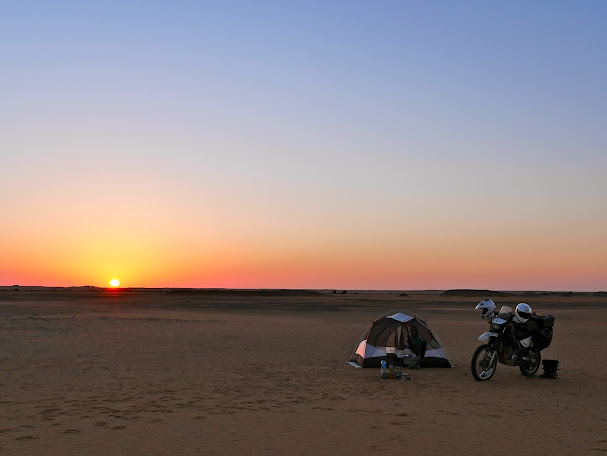
Just when you begin to fancy yourself a truly intrepid adventurer in the heart of an unforgiving land, some grizzled guy shows up on a bicycle to remind you that you’re not. This heroic Japanese dude had ridden from Alaska to the bottom of South America, and he is now on route from Cairo to Cape Town. What a legend.
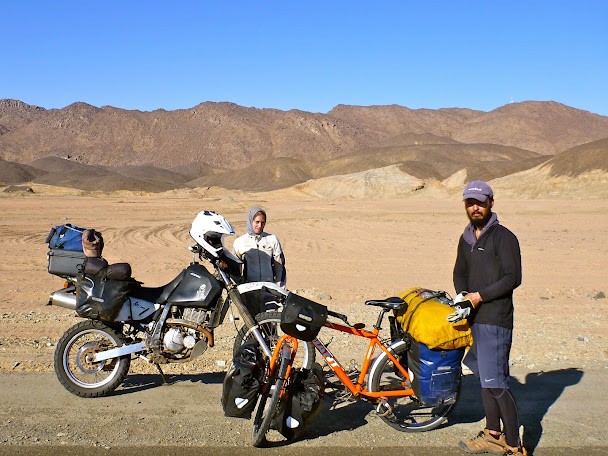
For the people, vegetation, and animals here, the Nile is life. A narrow verdant corridor winds its way through the desert, flanked on either side by the desert waste. There are oases here and there, but for the most part, survival has for millennia been utterly dependent this single river that is the only water source. Away from the river corridor the landscape kind of resembles Mars. Jamie went for a spacewalk.

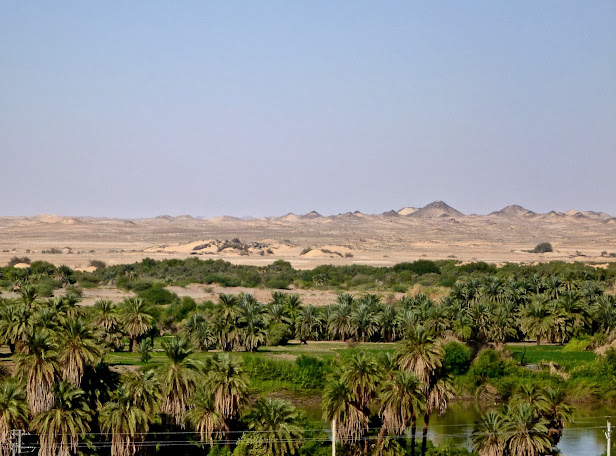
We’d visited the source of the headwaters of the White Nile in Rwanda, the source of the Blue Nile at Lake Tana in Ethiopia, and seen their confluence in Khartoum. If all goes as planned, we’ll follow these waters as they twist their way north through the Egyptian desert.
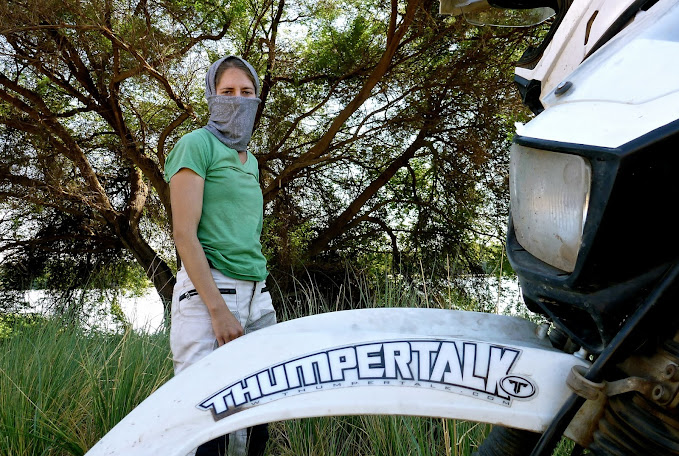
Making it in and out Sudan on a dodgy Carnet was a pretty good trick, but it will be another matter to do so in Egypt, where they have some of the tightest import regulations and exhaustive customs formalities anywhere in Africa. No one has dealt with more of these documents than the Egyptian customs folks and I worried that they would put a premature end to our document deception. We rode on towards the Egyptian border feeling bold and hoping that fortune would indeed favor us.
|

4 Jan 2015
|
 |
Registered Users
Veteran HUBBer
|
|
Join Date: Jan 2006
Location: Yuma, Arizona, USA
Posts: 548
|
|
|
Wow, all that headache for a visa, and it ended up taking a guy named 'Madhat' just a few moments, LOL. Can't wait to read what it takes to get into Egypt, and what adventures Egypt holds for you.
|

8 Jan 2015
|
 |
Registered Users
Veteran HUBBer
|
|
Join Date: Nov 2010
Location: Santa Cruz, California
Posts: 316
|
|
Quote:
Originally Posted by yuma simon

Wow, all that headache for a visa, and it ended up taking a guy named 'Madhat' just a few moments, LOL. Can't wait to read what it takes to get into Egypt, and what adventures Egypt holds for you.
|
Medhat is the man. In case you find yourself trying to get into Sudan, just drop his name ;-)
|
|
Currently Active Users Viewing This Thread: 1 (0 Registered Users and/or Members and 1 guests)
|
|
|
 Posting Rules
Posting Rules
|
You may not post new threads
You may not post replies
You may not post attachments
You may not edit your posts
HTML code is Off
|
|
|
|

Check the RAW segments; Grant, your HU host is on every month!
Episodes below to listen to while you, err, pretend to do something or other...

2020 Edition of Chris Scott's Adventure Motorcycling Handbook.
"Ultimate global guide for red-blooded bikers planning overseas exploration. Covers choice & preparation of best bike, shipping overseas, baggage design, riding techniques, travel health, visas, documentation, safety and useful addresses." Recommended. (Grant)

Led by special operations veterans, Stanford Medicine affiliated physicians, paramedics and other travel experts, Ripcord is perfect for adventure seekers, climbers, skiers, sports enthusiasts, hunters, international travelers, humanitarian efforts, expeditions and more.
Ripcord Rescue Travel Insurance™ combines into a single integrated program the best evacuation and rescue with the premier travel insurance coverages designed for adventurers and travel is covered on motorcycles of all sizes.
(ONLY US RESIDENTS and currently has a limit of 60 days.)
Ripcord Evacuation Insurance is available for ALL nationalities.
What others say about HU...
"This site is the BIBLE for international bike travelers." Greg, Australia
"Thank you! The web site, The travels, The insight, The inspiration, Everything, just thanks." Colin, UK
"My friend and I are planning a trip from Singapore to England... We found (the HU) site invaluable as an aid to planning and have based a lot of our purchases (bikes, riding gear, etc.) on what we have learned from this site." Phil, Australia
"I for one always had an adventurous spirit, but you and Susan lit the fire for my trip and I'll be forever grateful for what you two do to inspire others to just do it." Brent, USA
"Your website is a mecca of valuable information and the (video) series is informative, entertaining, and inspiring!" Jennifer, Canada
"Your worldwide organisation and events are the Go To places to for all serious touring and aspiring touring bikers." Trevor, South Africa
"This is the answer to all my questions." Haydn, Australia
"Keep going the excellent work you are doing for Horizons Unlimited - I love it!" Thomas, Germany
Lots more comments here!

Every book a diary
Every chapter a day
Every day a journey
Refreshingly honest and compelling tales: the hights and lows of a life on the road. Solo, unsupported, budget journeys of discovery.
Authentic, engaging and evocative travel memoirs, overland, around the world and through life.
All 8 books available from the author or as eBooks and audio books
Back Road Map Books and Backroad GPS Maps for all of Canada - a must have!
New to Horizons Unlimited?
New to motorcycle travelling? New to the HU site? Confused? Too many options? It's really very simple - just 4 easy steps!
Horizons Unlimited was founded in 1997 by Grant and Susan Johnson following their journey around the world on a BMW R80G/S.
 Read more about Grant & Susan's story
Read more about Grant & Susan's story
Membership - help keep us going!
Horizons Unlimited is not a big multi-national company, just two people who love motorcycle travel and have grown what started as a hobby in 1997 into a full time job (usually 8-10 hours per day and 7 days a week) and a labour of love. To keep it going and a roof over our heads, we run events all over the world with the help of volunteers; we sell inspirational and informative DVDs; we have a few selected advertisers; and we make a small amount from memberships.
You don't have to be a Member to come to an HU meeting, access the website, or ask questions on the HUBB. What you get for your membership contribution is our sincere gratitude, good karma and knowing that you're helping to keep the motorcycle travel dream alive. Contributing Members and Gold Members do get additional features on the HUBB. Here's a list of all the Member benefits on the HUBB.
|
|
|















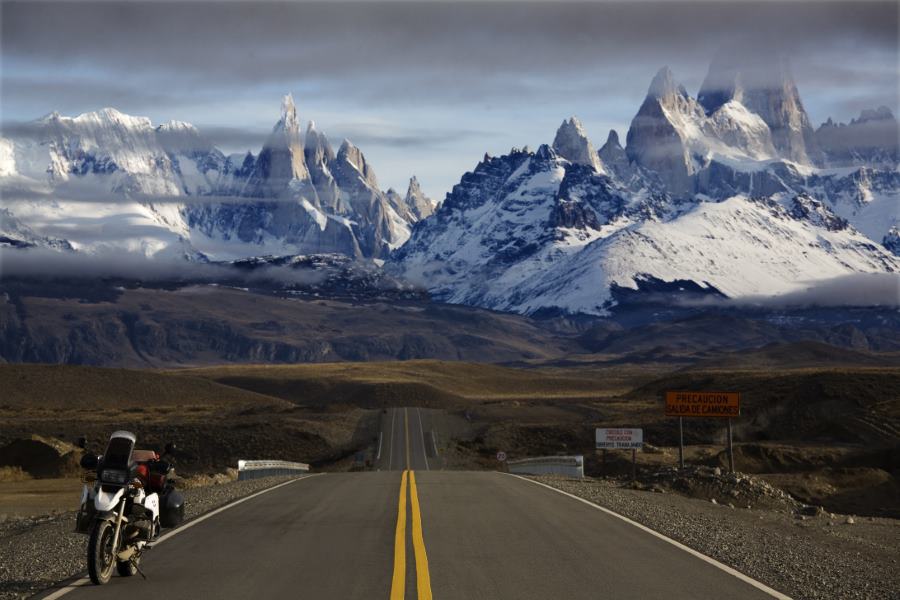

 134Likes
134Likes












 Linear Mode
Linear Mode










